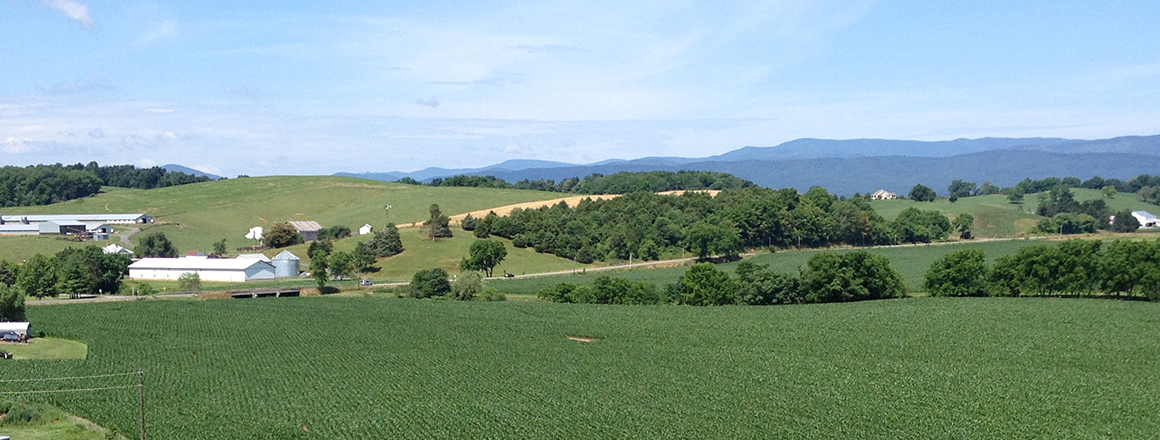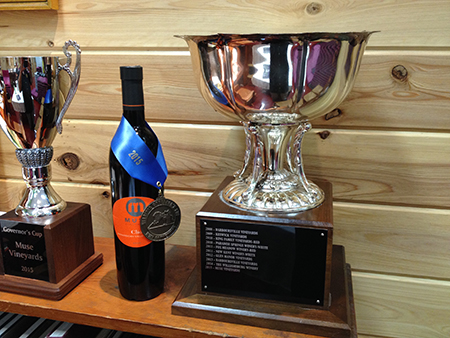This month I traveled around Virginia wine country from the Monticello AVA to northern Loudoun to the Shenandoah Valley. Some of that time I traveled with the long-standing Canadian wine writer Edward Finstein (“The Wine Doc”) who was on a magazine assignment. Thanks to fine wines and well-air conditioned vehicles he came away with a favorable impression of Virginia wine despite the heat.
Here are highlights of the month:
Breaux Vineyards
Under new winemaker Heather Mundon (on the job about a year), Breaux has really solidified its product line with consistent high quality. While the reserve wines are impressive, the six wines on the regular tasting are all very well made and offer very versatile range of styles with something for everyone. With 100 acres of vines, most everything is estate bottled with the nervy acidity and fresh fruit of northern Loudoun County.
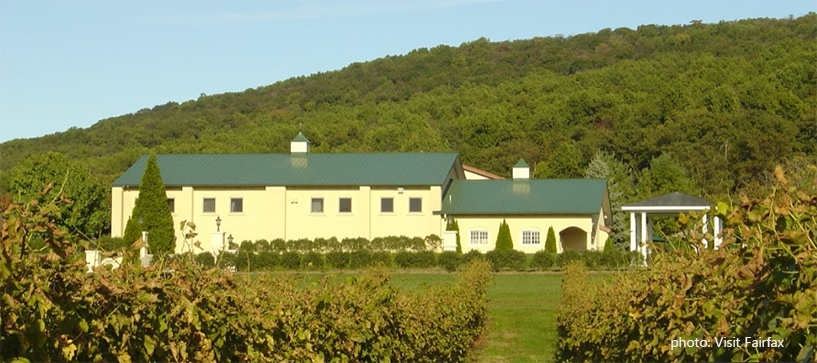
These six wines are:
- the 2014 Jolie Blond, a high-acid Loire Valley-like seyval blanc, competitive with New Zealand sauvignon blanc, with lots of white grapefruit and refreshing acidity.
- 2014 Viognier, elegant and complex with white flowers, tropical fruits, a round mid-palate but pleasingly fresh finish.
- Equation (NV) This is a merlot-based blend that, last I had it 3-4 years ago, I was not impressed with, but this wine was very different: stylish red and black fruits deftly blended with oak, hints of mocha in the finish but fresh and clean. Very versatile to enjoy by itself or food, even slightly chilled for summer.
- 2013 Marquis De Lafayette, the label for Breaux’s varietal cabernet franc, is in a classic Virginia style; red cherry and chocolate notes, smooth tannins and fine fruit/oak integration. Will be great this fall.
- 2007 Cabernet Sauvignon: It’s a treat to pay no extra to taste a library cabernet from a great vintage. This is a hefty cabernet but the wine has mellowed well, with classic aroma notes of red cassis and cigar box. On the palate, it’s full-bodied but well-balanced with a long, clean finish; a rare treat.
- 2013 Chere Marie is 100% vidal blanc, with citrus and melon notes, and although it’s 2% residual sugar, it seems drier, with very good fruit/acid balance and fresh finish; great for sipping anytime and versatile with food.
Keswick Vineyards
At Keswick Vineyards east of Charlottesville, the 2014 wines have been released, and my favorite was the V2, this year a blend of 70% verdejo (an aromatic Spanish white grape) and 30% viognier. The nose had a lovely fragrance of citrus, pear and white flowers. On the palate, the wine was zippy and bright with floral and citrus notes. Delicious, dry and elegant.
Another fine 2014 was the Consensus Blend (disclosure: I was one of the judges evaluating final blends). 68% chambourcin, 27% syrah with small amounts of touriga and norton, this wine was edgy when I judged it in February but has come together nicely and is an excellent warm-weather red. On the nose it is juicy, fun and fruity. On the palate, it continues that way and is very fun, original, fruity and drinkable. Although dry it is not tannic.
The 2013 Homage de Genevive viognier is a fine example of the style Virginia is defining for the grape. The nose has gentle hints of white flowers, peach, and apricot. On the palate, there is huge peach with apricot flavors and a slight sweetness, but with a refreshing finish.
Horton Vineyards
At Horton Vineyards, the “Wine Doc” and I were most impressed with the 2014 nebbiolo rosé (aromas of passion fruit, lively on the palate with passion fruit/strawberry flavors); the 2013 malbec (dark ruby, excellent aromatics of sandlewood and blueberry, juicy and vibrant on the palate, and a great deal at $15); and the 2012 syrah (white pepper and red cherry notes on the nose, “roasted” red cherries and spice on the palate with a long finish; very Rhone-like).
Barboursville Vineyards
At Barboursville Vineyards, the star of current wines is the 2014 vermentino, a grape from Sardinia that is making a stylish white wine like a Ferrari version of pinot grigio. The nose had a large volume with notes of spicy pear and nectarine. On the palate, it was richly tactile but with HUGE nectarine and peach flavors, then firm, racy acidity. Distinctive and stylish, a great aromatic white for food matching.
Tasting library wines in their library room (a classy alternative to the crowded tasting room), we were particularly impressed with the 2008 merlot, featuring fresh red fruits and herbs, very “Right Bank”. On the palate, I thought of St. Emilion, with the fresh, crisp texture, nice blend of red fruits and herbs.
The star was, no surprise, the 2009 Octagon (Governor’s Cup winner). On the nose, coconut oak tones and lots of baking spices blended with subtle red fruits. On the palate, the wine has huge depth and dimension, plush and spicy. It’s young and needs time but will be worth the wait; drink 2018 or later.
We were also impressed with their (non-Virginia) sparkling wines; a brut rose of pinot noir from the Oltrepopavese region of Lombardy, frothy with fine mousse and a lively nose of cherry and strawberry with yeast notes. The palate was dry with great finesse and balance of bright red fruits and cream.
The most original wine we tasted was their white sparkling wine (also from Lombardy) that was 14 years (!) en tirage or on the lees. For comparison, vintage champagne from France is usually en tirage for five years. The years on the lees give mellowness and complexity to the wine and take the edge of the acidity. This wine was made to celebrate the 200th anniversary of the founding of the Zonin (Barboursville’s parent company) family wine business.
The wine was remarkable: butterscotch, hazelnut and toasty caramel aromas, followed by like flavors but with a dry and fresh finish.
Early Mountain Vineyards
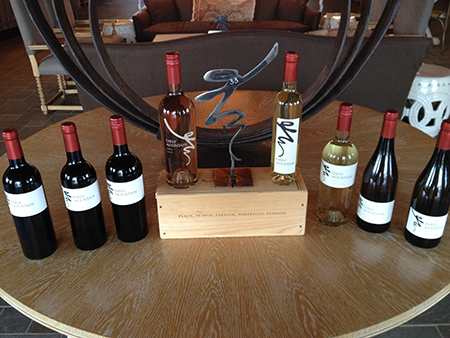 Early Mountain Vineyards brought some welcome new releases from 2014, including their pinot gris, rose and Block 11 white blend.
Early Mountain Vineyards brought some welcome new releases from 2014, including their pinot gris, rose and Block 11 white blend.
The 2014 pinot gris had a nose more like the Alsatian style than Italian pinot grigio with hints of spicy pear. On the palate, it was richly round but with a bright fresh finish, just what you’d want to order in a restaurant for wide versatility.
The 2014 rosé was made from merlot fruit that winemaker Jon Hollerith explained expressed better character for rosé than for red wine and was picked early for optimal rose character (also blended with some malbec). The nose was light with bright fresh watermelon and strawberry. On the palate, the wine was delicate in the Provencal style, dry but delicate and with herbal and mineral notes and not too acidic.
The Block 11 white is a blend of petit manseng and muscat. On the nose, nice herbal, sauvignon blanc-like notes, then floral muscat. On the palate the wine is juicy and brightly acidic with tangerine and passion fruit; lots of fun, fruity and dry.
The Eluvium 2012 is a “Right Bank”-style blend of 50% merlot, with smaller amounts of the two cabernets. On the nose, ripe, juicy red and black fruits with hints of chocolate/mocha and oak. On the palate, the wine is rich and lively, with spice and herbal notes, still young but promising.
The Foothills Red 2013 is also a “Right Bank” merlot-dominated blend but I think even more stylish and promising. VERY “Right Bank” on the nose; earth and dried red fruits and spice/cedar. On the palate, amazingly like St. Emilion w. fresh acidity, red fruits and chocolate/mocha on finish. This elegant, stylish (and non-oaky!) red follows a successful model for high-end Virginia red blends based on merlot and cabernet franc, and this one is stunningly like a St. Emilion Grand Cru wine in ways you just can’t fake with powdered additives or such.
Bluestone Vineyards
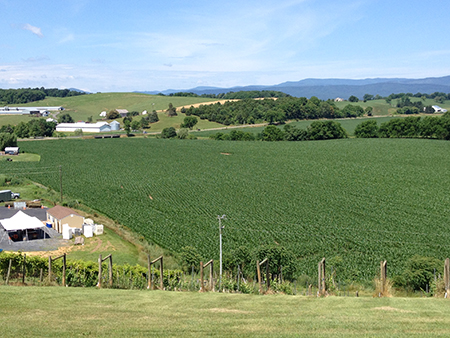
They don’t call this (foreground) vineyard slope at Bluestone the “steep face” for nothing.
Crossing into the Shenandoah Valley, our first stop was Bluestone Vineyards, first planted as a “hobby” vineyard in 2000 but with its first serious commercial planting in 2008. Although fairly new on the scene, Bluestone has made impressive awards for its wines both in and out of state, including several gold medal wines in the Governor’s Cup competition the last couple of years. Although I wouldn’t recommend anyone in the Valley plant cabernet sauvignon, their hilly, well-drained site west of Bridgeport ripens that grape well and they’ve won top awards with it.
We tasted a dry norton port right from whiskey barrels in the cellar. It was richly ripe with a dark, spicy nose of damson plum and boysenberry. On the palate, alcohol was high (15.8%) as well as acidity, but young, vibrant and clean. The wine is dry with firm acid and needs time and oxygen but is pure and admirable.
The Steep Face chambourcin 2013 was made from a block of vines planted on a literally steep west-facing slope, and is a great validation of the reputation of chambourcin in the Valley. Dark purple/ruby color, and subtle spicy black cherry with flint notes on the nose. On the palate, the wine was juicy with fresh red/black cherry flavors, nice and round on the finish with good acid and fruit integration. The “wine doc” was impressed because he hasn’t had fully ripened chambourcin from Canadian vines.
The Bluestone meritage 2010 won a gold medal in this year’s Virginia Governor’s Cup competition, made from 33% each of the two cabernets and merlot, with 50% new French oak. On the nose, big, rich, hefty ripe red fruits, offset by fine earth and herbal notes. On the palate, a bit high alcohol, but smooth, ripe, warm, round and well-integrated. Well-deserved gold medal.
Blue Ice 2013 is a cryo-wine made from artificially frozen traminette grapes. The nose was lovely lychee and grapey muscat-like fruitiness. On the palate, it showed excellent fruit/acid balance with ripe rich fruit but with a fine zesty citrus finish. Very stylish example of top quality for grapes picked ripe then artificially frozen and pressed.
Muse Vineyards
Our next stop was Muse Vineyards west of Woodstock, who won the 2015 Virginia Governor’s Cup with their excellent “Clio” 2009 (red meritage-style blend, equal parts the two cabernets, merlot and petit verdot) made from the first fruit of vines planted in 2007 and 2008. Tasting this wine again was a vindication of the Cup judging; the nose was lively, focused, flinty mineral with bright ripe red fruits. On the palate, there was excellent balance of fruit, acid and oak. The wine is young but fruit-driven and will age well. Outstanding and fresh.
Also impressive at Muse were the roussane 2013 with spicy pear aromas and flavors, rich viscosity but flinty, mineral finish; and the grenache 2013 (labeled “Calliope”). This wine is kind of amazing because the grenache grape is tight-bunched and easily prone to rot, but in the Shenandoah Valley at this site can be grown sustainably.
Not only were the grapes clean but the wine is remarkably Rhone-like (as was the roussane); light ruby color, with classic notes of white pepper and raspberry/red cherry on the nose, followed by clean leather and sour cherry on the palate, with firm acid and a lively finish. Much closer to Chateauneuf-du-Pape than to West Coast or Australian or even Spanish examples.
Philip Carter Winery
Crossing the Blue Ridge Mountains on I-66 we drove south to Hume and tasted the wines of Philip Carter Winery and then enjoyed them at dinner, at the Inn at Vineyards Crossing, an elegant. Emmanuel, the new winemaker at Philip Carter, is French but has worked at Wineworks and elsewhere in the Virginia industry.
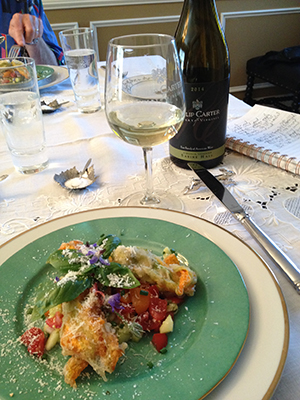
The fine Philip Carter 2014 viognier with an appetizer/salad course at the Inn at Vineyards Crossing, Hume
The 2014 viognier was delicate but elegant, with fresh white flowers, white peach and ginger on the nose. On the palate, the wine was juicy and rich with a rich texture yet still vibrant, fresh yet fleshy. Ripe peach and nectarine flavors ended with fine balance.
The 2014 rosé (100% merlot) was in the Provencal style, with lots of strawberry on the nose, juicy but very dry and intense red fruit flavors, lively with great fruit/acid balance.
The 2010 meritage (42% cabernet franc, 32% petit verdot, 21% cabernet sauvignon, 5% merlot) had rich, ripe black fruits on the nose, with a whiff of alcohol (13.8%) but on the palate, not too hot. Flavors of cocoa and coffee were matched with brisk acidity. The wine is both fresh and young, while ripe and rich. Stylishly fruit-driven and elegant.
Lastly, I was quite impressed with the 2013 “1762″ port-style wine, an original blend of 80% barbera and 20% chambourcin. On the nose, a pleasing combination of smoky black cherry from the barbera and red cherry from the chambourcin. On the palate, black raspberry, juicy but fresh, clean, no alcohol burn, (18%), easy to quaff. Aged in whiskey barrels which advance the maturation process. $38/500 ml bottle, but if you like fine port-style wines and want to support Virginia wineries this is one of the better ones.
The Inn at Vineyards Crossing
is correctly described as “an intimate and romantic retreat in Virginia wine & hunt country” and I recommend it for those who want a well-situated and elegant place from which to explore Fauquier County wineries. It features a swimming pool and four o’clock afternoon wine tastings.

